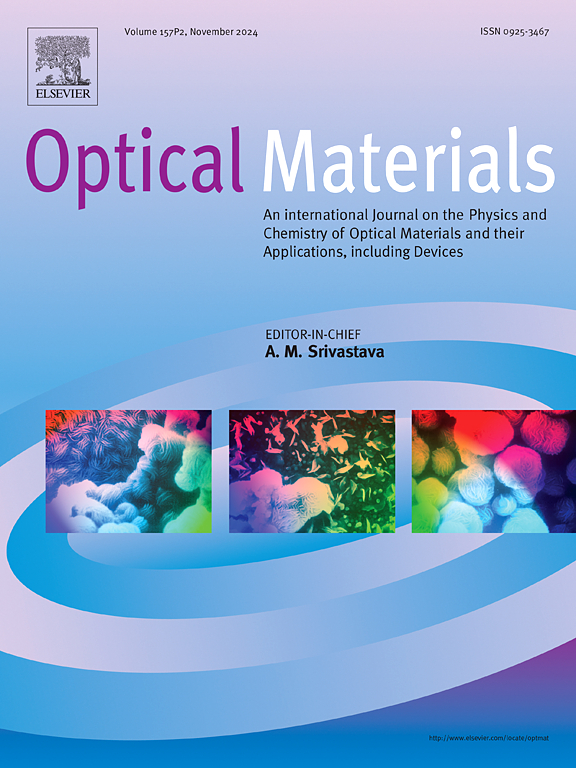Complex index of refraction of MBE grown 1 eV GaInAsNSb dilute nitride layers as a function of thermal annealing
IF 3.8
3区 材料科学
Q2 MATERIALS SCIENCE, MULTIDISCIPLINARY
引用次数: 0
Abstract
In this work, 1 eV GaInNAsSb layers with different thickness have been annealed to study the impact that the thermal treatments have on their optical properties. For such purpose, GaInNAsSb layers with thicknesses of 0.2, 1 and 3 μm were grown lattice-matched onto GaAs substrates. Each epiwafer was cut into four quarters: one quarter was left as the as-grown sample, another one was submitted to a Rapid Thermal Annealing, the third quarter was annealed in a Metal Organic Vapor Phase Epitaxy reactor, and the fourth one was submitted to the first annealing followed by the second one. The complex index of refraction of the samples has been determined using spectroscopic ellipsometry along a wide spectral range (250–2500 nm). The optical properties of the 1 and 3 μm as grown layers do not differ very much between them, while the 0.2 μm layer exhibits a particular behavior that can be correlated with similarities/differences in the dilute nitride layer composition. The two types of thermal annealing affect in a different way to both composition and optical properties of the GaInNAsSb layers depending on their thicknesses. Finally, the obtained refractive indices and extinction coefficients have been validated by simulating the experimental reflectance of the semiconductor structures. Therefore, the determination of the optical properties (ranging from 250 to 2500 nm) of 1 eV GaInNAsSb we present here, allows the simulation and optimization of optoelectronic devices incorporating this dilute nitride.
MBE生长1ev GaInAsNSb稀氮层的复折射率与热退火的关系
本文对1 eV不同厚度的GaInNAsSb层进行了退火,研究了热处理对其光学性能的影响。为此,将厚度分别为0.2、1和3 μm的GaInNAsSb层以晶格匹配方式生长在GaAs衬底上。每个外延片被切成四分之一:留下四分之一作为生长样品,另一个提交到快速热退火,第三个提交到金属有机气相外延反应器中退火,第四个提交到第一次退火,然后是第二次退火。在较宽的光谱范围内(250 ~ 2500 nm),利用椭圆偏振光谱法测定了样品的复折射率。1 μm和3 μm层的光学性质差异不大,而0.2 μm层的光学性质与稀氮层组成的异同有关。这两种类型的热退火以不同的方式影响GaInNAsSb层的组成和光学性质,这取决于它们的厚度。最后,通过模拟半导体结构的实验反射率,验证了所得的折射率和消光系数。因此,我们在这里提出的1 eV GaInNAsSb的光学性质(范围从250到2500 nm)的测定,允许模拟和优化包含这种稀释氮化物的光电器件。
本文章由计算机程序翻译,如有差异,请以英文原文为准。
求助全文
约1分钟内获得全文
求助全文
来源期刊

Optical Materials
工程技术-材料科学:综合
CiteScore
6.60
自引率
12.80%
发文量
1265
审稿时长
38 days
期刊介绍:
Optical Materials has an open access mirror journal Optical Materials: X, sharing the same aims and scope, editorial team, submission system and rigorous peer review.
The purpose of Optical Materials is to provide a means of communication and technology transfer between researchers who are interested in materials for potential device applications. The journal publishes original papers and review articles on the design, synthesis, characterisation and applications of optical materials.
OPTICAL MATERIALS focuses on:
• Optical Properties of Material Systems;
• The Materials Aspects of Optical Phenomena;
• The Materials Aspects of Devices and Applications.
Authors can submit separate research elements describing their data to Data in Brief and methods to Methods X.
 求助内容:
求助内容: 应助结果提醒方式:
应助结果提醒方式:


